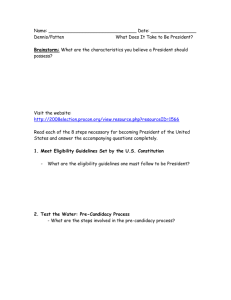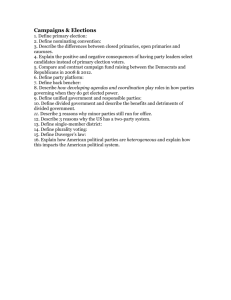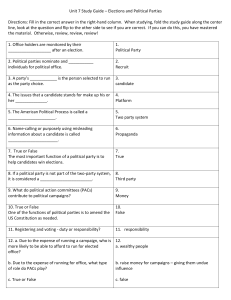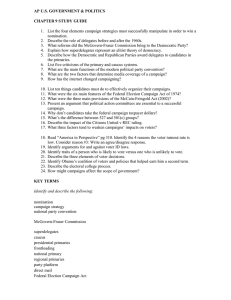Chpt 11 Campaigs and Elections_1
advertisement
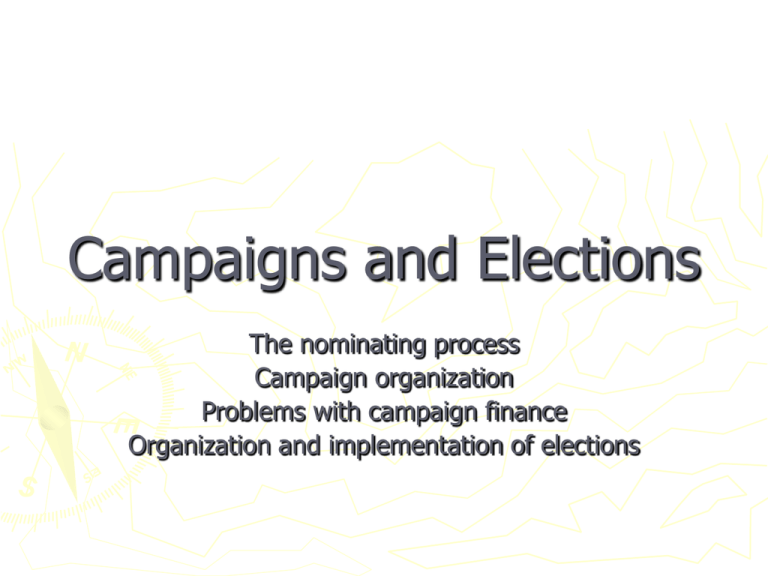
Campaigns and Elections The nominating process Campaign organization Problems with campaign finance Organization and implementation of elections The nomination ► The 1st step: choosing of candidates within each party ► Narrows the field of possible candidates ► Self Nomination= was the main way until the 1800’s (still used in small towns) ► Candidate must file a petition to be on the ballot (number of signatures varies per state) ► If not enough signatures to get on ballot, can be a “write-in candidate” Rarely successful Party Caucus ► Constitution doesn’t give instructions for nominating candidates for Pres./V.P.. ► 1797, party leaders (wealthy, influential) decided to keep power by holding caucuses Early meetings where party leaders chose candidates in secret (voters had no part) ► By 1820, caucuses were controversial, “King Caucus”…they faded away. Party Nominating Convention ► Replaced caucuses ► Official meeting of a political party candidates and delegates are chosen. Both systems have been abused Most states don’t use conventions National convention still used The Direct Primary ► Replaced convention system in most states. ► An election held within each party to pick candidates for the general election. ► States usually set the dates and conduct. ► Different kinds of primaries Closed primary Open primary Run-Off Primaries Nonpartisan elections Nominating Presidential Candidates ► Begins with state primaries, caucuses and conventions, which are followed by the national party conventions. State parties, caucuses or conventions National party conventions ► Adopt the official party platform ► Decide who will be the party’s v.p. and pres. Candidates ► 2-3000 delegates ► Not as important in the nominating process as they once were. The Campaign Campaign- originally a military word ► To win = organized, well planned, $ *see diagram on pg. 299 ► Campaign Strategy Aggressive vs. low key, issues?, theme/slogan? $ for t.v. etc… ►Traditional Techniques Door to door ►Mass media and computerized techniques ►Opinion polls (tracking polls) 3 ways campaigns make a difference ► Reawaken partisan loyalties of voters Right after a nomination, that persons popularity with both parties goes up. Media attention during the summer months when not much else is going on. ► See how candidates handle pressure Negative ads work by stimulating voter turnout ► Allow the voter to judge the core values/character of the candidate. Campaign costs ► Campaign finance laws Campaign-Financing Laws ► 1971- FECA Federal Election Campaign Act No limits on overall spending Restricted amount to be spent on mass media Limited amount that candidates and their families could contribute to their own campaigns Required candidates to disclose all expenditures and contributions over $100 $1 checkoff on federal income tax returns (has since been raised to $3) Amendments to the Act: 1974 Created the Federal Election Commission (FEC) for enforcement. ► Public financing for presidential primaries and general elections. ► Limits on pres. Campaign spending: if you agree to fed. Support, you must agree to limit expenditures. ► Required disclosure. ► Limited contributions: citizens can give up to $1000/candidate in each fed election or primary. Total limit for any individual in one year is $25,000. Groups can contribute a max of $5,000 to a candidate in any election. ► 1976 Case: Buckley v. Valeo- court ruled unconstitutional the part that limits amount candidate can spend on his/her own campaign ► Barack Obama ► Barack Obama became the first presidential nominee to opt out of the public funding system set up after the Watergate scandal. ► To date, he has raised nearly $650 million (Nov. 4th 2008) ► By contrast, John McCain, who opted for public funds has raised about 360 million dollars overall.
